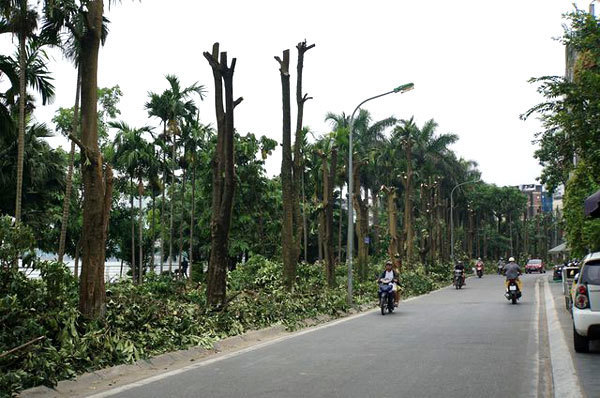Hanoi removes more than 100 trees for unpleasant odour
 |
| Many alstonia scholaris trees on Hanoi's Trich Sai Street were cut off to transfer to Soc Son District's Nam Son landfill. — Photo dantri.com.vn |
The flower is also mentioned in famous songs and poems such as Nhớ mùa thu Hà Nội (Remember Ha Noi’s autumn) by Trinh Cong Son, Em ơi Hà Nội phố (My dear, Ha Noi Streets) by Phu Quang and Phan Vu and Hoa sữa (Milk flower) by Hong Dang.
When news broke that nearly 100 milk flower trees along Trich Sai Street near the West Lake will be moved to the Nam Son rubbish dump in Soc Son District, many people were surprised and disgusted.
Do Tuan Anh, chairman of the Tay Ho District People’s Committee, said the decision was made by municipal authorities. The trees started to be moved last Wednesday by the committee, in coordination with the Ha Noi Department of Construction. The work is scheduled to last a month.
Anh said residents had complained about the trees as they were too thick and smelled strong because too many were planted too close together.
After the move, the municipal authorities will gather opinions from experts and residents as to their replacement.
"The district does not have enough land to plant 96 trees. Planting them near a large garbage dump will improve the sight and smell of the area," he said.
Architect Tran Huy Anh, a member of the Ha Noi Architect Association, said the rubbish dump was a polluted place and trees often attract insects.
The insects, together with the pollution from the rubbish, would help spread diseases, he said.
Moreover, Anh added, to treat the pollution from the rubbish dump, chemicals would be needed, not trees.
Phan Thu Trang, from Thanh Xuan District, worries about the mixture of smells after the move.
“Milk flowers have a special aroma, if it goes together with the bad smell from the dump, the new smell will be much more unpleasant,” she said.
Residents, who have had to live with the bad smell from the rubbish dump for many years, now could suffer from more problems.
However, the plan was praised by experts.
Associate professor Dang Van Ha, deputy director of the Landscape Architecture and Urban Greenery Institute, said milk flower trees grew quickly and adapted easily to soil types thus were suitable for landfills.
Tree roots also absorb organic matter and reduce odours.
"The milk flower season lasts longer than a month, the range extends to less than 100m. Meanwhile, the dump is far from residential areas, so it does not affect inhabitants of this area," said Ha.
Ha believes that the plants are not suitable for growing on the street because the smell and pollen can cause allergies, especially for people with respiratory disorders. This plant should only be grown in parks with a density of 150-200m per tree.
Herbalist Vu Quoc Trung, from the Ha Noi Oriental Medicines Association, told the Đời sống Plus e-newspaper that milk flower trees had medicinal properties, especially in treating diarrhoea and digestive disorders.
Several other countries such as India and Philippines use milk flowers in remedies, he said.
Many people from Hanoi now live far from the capital city, but remember the flowers as an integral part of the capital.
The challenge is how to keep the environment clean and reduce air pollution around Nam Son rubbish dump while maintaining the beautiful image of milk flowers.
This issue needs careful consideration, with the input of residents and concerned organisations. In this way we can have both a hygienic rubbish dump and the enduring charm image of milk flowers, not only in songs and poems, but also in the hearts of people from Hanoi. VNS
Thu Trang
 Milk flowers, or hoa sữa, are a familiar sight for Hanoians. They are praised as a symbol of the capital city’s beauty, besides other famous spots like Hoan Kiem (Returned Sword) Lake, Van Mieu-Quoc Tu Giam (Temple of Literature) and the Old Quarter.
Milk flowers, or hoa sữa, are a familiar sight for Hanoians. They are praised as a symbol of the capital city’s beauty, besides other famous spots like Hoan Kiem (Returned Sword) Lake, Van Mieu-Quoc Tu Giam (Temple of Literature) and the Old Quarter.